基于全局局部空间感知的高光谱图像降维保留投影
IF 3.4
3区 物理与天体物理
Q2 INSTRUMENTS & INSTRUMENTATION
引用次数: 0
摘要
高光谱遥感图像受噪声干扰和采集设备的限制,往往存在严重的“异质目标间光谱混淆(SCHT)”和“均匀目标内光谱变异性(SVHT)”现象。传统的基于局域保持投影(LPP)的降维方法由于忽略了空间背景结构,不能有效地捕捉复杂的空间光谱特征。为了解决这一问题,本文提出了全局-局部空间感知保持投影(GLSAPP)框架,该框架通过空间-光谱联合建模实现双优化。一方面,通过整合空间距离邻域和光谱相似邻域构建复合邻域结构,设计了光谱一致性和空间相干性的双加权机制;该机制自适应地增强了流形学习过程中的类内紧密性和类间可分辨性。另一方面,提出了一种新的局部特征散度指标和全局类分离指标来衡量SCHT和SVHT现象。建立了包含局部几何保持项和全局排斥正则化项的联合优化模型。在三个公开的高光谱数据集上进行的实验表明,与最先进的降维方法相比,GLSAPP显著降低了SCHT率和SVHT率。这些结果验证了GLSAPP通过空间-光谱协同优化抑制光谱变异性和混淆的有效性,为高光谱图像分类提供了一种更准确的特征表示方法。本文章由计算机程序翻译,如有差异,请以英文原文为准。
Global-local spatially aware preserving projection for dimensionality reduction of hyperspectral images
Hyperspectral remote sensing images, constrained by noise interference and acquisition equipment limitations, often suffer from severe phenomena of ‘spectral confusion between heterogeneous targets (SCHT)’ and ‘spectral variability within homogeneous targets (SVHT)’. Conventional dimensionality reduction methods based on locality preserving projection (LPP) fail to effectively capture complex spatial–spectral features due to their neglect of spatial context structures. To address this challenge, this paper proposes the global-local spatially aware preserving projection (GLSAPP) framework, which achieves dual optimizations through spatial–spectral joint modeling. On the one hand, a composite neighborhood structure is constructed by integrating spatial distance neighborhoods and spectral similarity neighborhoods, and a dual-weighting mechanism for spectral consistency and spatial coherence is designed. This mechanism adaptively enhances intra-class compactness and inter-class discriminability during manifold learning. On the other hand, a novel local feature divergence metrics and a global class separation indices are proposed to measure the phenomena of SCHT and SVHT. A joint optimization model incorporating local geometric preservation terms and global repulsive regularization terms is then established. Experiments conducted on three publicly available hyperspectral datasets demonstrate that compared with state-of-the-art dimensionality reduction methods, GLSAPP significantly reduces both SCHT rate and SVHT rate. These results validate the effectiveness of GLSAPP in suppressing spectral variability and confusion through spatial–spectral collaborative optimization, providing a more accurate feature representation method for hyperspectral image classification.
求助全文
通过发布文献求助,成功后即可免费获取论文全文。
去求助
来源期刊
CiteScore
5.70
自引率
12.10%
发文量
400
审稿时长
67 days
期刊介绍:
The Journal covers the entire field of infrared physics and technology: theory, experiment, application, devices and instrumentation. Infrared'' is defined as covering the near, mid and far infrared (terahertz) regions from 0.75um (750nm) to 1mm (300GHz.) Submissions in the 300GHz to 100GHz region may be accepted at the editors discretion if their content is relevant to shorter wavelengths. Submissions must be primarily concerned with and directly relevant to this spectral region.
Its core topics can be summarized as the generation, propagation and detection, of infrared radiation; the associated optics, materials and devices; and its use in all fields of science, industry, engineering and medicine.
Infrared techniques occur in many different fields, notably spectroscopy and interferometry; material characterization and processing; atmospheric physics, astronomy and space research. Scientific aspects include lasers, quantum optics, quantum electronics, image processing and semiconductor physics. Some important applications are medical diagnostics and treatment, industrial inspection and environmental monitoring.

 求助内容:
求助内容: 应助结果提醒方式:
应助结果提醒方式:


